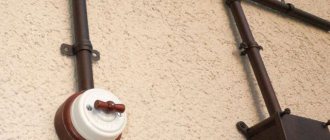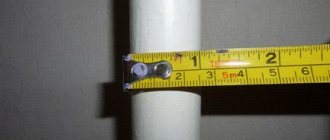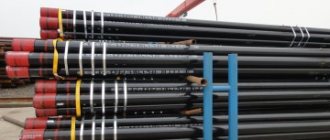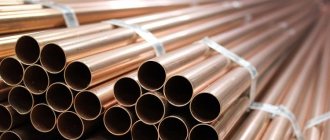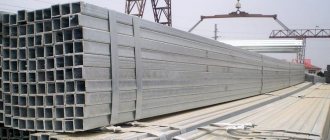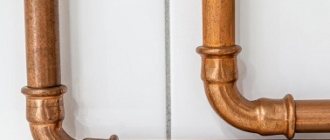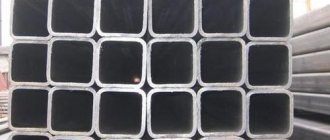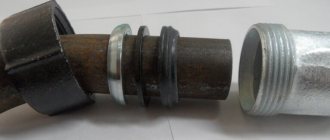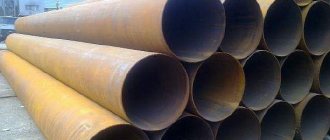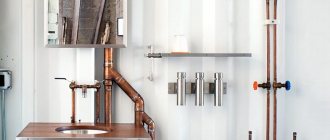Metal pipes can currently be used for various purposes, one of which is electrical installation. The most difficult and important stage of cable laying work is compliance with fire safety standards and requirements, especially if wooden structures are involved. Metal pipes for electrical wiring can reliably protect communication networks from mechanical damage, as well as aggressive environments.
Open wiring in metal pipes can be an original solution for room decoration
Types of channels for electrical wiring
The choice of tube material depends on the type of room where the wiring is performed, its conditions and features. Among the main channel materials for such purposes are:
- plastic;
- steel;
- copper;
- brass.
For the manufacture of plastic models, polyvinyl chloride, high-pressure (H) and low-pressure (D) polyethylene (P) are used. PVC products are the most popular due to their affordable cost, good heat resistance and strength. Common diameters range from 1.6 to 6.0 centimeters.
Plastic pipes are characterized by a smooth surface, which facilitates the work of replacing conductors, low weight, and resistance to corrosion.
Note! PVC and polyethylene channels are dielectrics, which allows them to be considered as an additional insulating circuit.
Thin pipes that are easy to bend are used for laying wires
Metal pipes for electrical wiring, made of steel, have a significant mass, however, they are characterized by particularly high strength. Such products are recommended for use in wooden buildings. Since the material is a good conductor, to ensure electrical safety, all such channels must be grounded. Thin-walled brass or copper tube is excellent for both mounting on wall surfaces and for hidden installation. It bends easily and does not always need decoration.
Wide selection of electrical goods
The Electro Decor electrical appliance store offers a variety of products for furnishing antique living spaces.
Here you will find all the necessary electrical installation products to suit your interior design. Even our wiring pipes fit perfectly into the overall design concept. They are made of high quality material and also look aesthetically pleasing and stylish.
To make the choice easier, all products on the website are divided into categories. In the catalog in the section “Pipes for wiring” you can filter products by parameters: price, brand, color, type of installation.
We have:
- pipes for outdoor installation;
- decorative pipes;
- tees;
- coupling;
- bypass;
- corner;
- fasteners;
- fastener clip;
- fixation clip;
- connecting corners of different types.
Some installation rules
Before installing a cable route made of thin-walled metal pipes for electrical wiring, you should familiarize yourself with the following rules:
- the ends of each piece of products need to be pre-cleaned from burrs and countersinked;
- the maximum permissible bending angle of the steel channel is 90 degrees;
- there is a limitation on the length of the sections: up to 10 meters in the case of a straight pipe, up to 5 meters - if there are 2 bends;
- When bending, it is important to monitor the integrity of the cross-section of the product;
- the metal channel must be made as part of the EPS (potential equalization system).
If it is impossible to meet the conditions for choosing the length of the pipes, according to the rules, it is necessary to install a pull-out box without additional joints.
The physical essence of the control system is the need to connect all conductive parts into a single system in such a way as to minimize or completely eliminate the potential difference between them. To do this, it must include:
- grounding device;
- main (D) grounding (G) bus (W), mounted in the electricity metering (U) board (E) or input board;
- All elements of the building's structure are made of metal.
If you adhere to these rules, you can significantly simplify the installation and replacement of electrical wiring.
Norms, technical conditions.
Smooth, rigid PVC pipes for electrical wiring are manufactured according to TU 6-19-215-83 . Rigid, smooth, electrical gray PVC pipes .
| № | Name of product | Wall thickness | Unit | In pack | Price per m/p |
| 1 | PVC smooth pipe D=16mm (50x3 meters) | 1,2 | m | 150 | 5.00 |
| 2 | PVC smooth pipe D=20mm (50x3 meters) | 1,5 | m | 150 | 6.90 |
| 3 | PVC smooth pipe D=25mm (40x3 meters) | 1,5 | m | 120 | 7.95 |
| 4 | PVC smooth pipe D=32mm (30x3 meters) | 1,8 | m | 90 | 13.95 |
| 5 | PVC smooth pipe D=40mm (20x3 meters) | 1,9 | m | 60 | 17.60 |
| 6 | PVC smooth pipe D=50mm (10x3 meters) | 1,8 | m | 30 | 22.50 |
| 7 | PVC smooth pipe D=63mm (10x3 meters) | 2,4 | m | 21 | 43.00 |
| 8 | PVC smooth pipe D=75 mm (7*3 meters) | 2,5 | m | 21 | 68,00 |
Prices are valid for orders over 100,000 rubles from the factory warehouse. For smaller orders prices increase by 10%. Retail prices (up to 10 packages of pipe) increase by 20%.
Features of copper and brass cable channels
Copper products for wiring are not in high consumer demand due to their high cost. Channels have the following features:
- Compared to steel, neither brass nor copper are subject to active corrosion;
- the possibility of quick installation with your own hands thanks to a wide selection of fittings and good bending properties of thin-walled tubes;
- carefully polished and installed in an open way, channels can serve as interior decoration.
Copper pipes are not subject to corrosion, so this cable channel will not need to be replaced for a long time
In addition, copper/brass routes are durable and resistant to the negative influences of external factors.
Note! Since these metals have good thermal conductivity, they must be placed away from heating pipes, otherwise there is a risk of insulation melting and overheating of the wiring.
Another disadvantage of choosing thin-walled cable channels is their inability to provide reliable protection from mechanical damage.
Where are rigid PVC pipes used?
Smooth reinforced PVC pipe is most often used when laying long electrical or telecommunication lines. It is not as elastic as corrugation, but is characterized by low cost and good strength indicators. A rigid, smooth PVC pipe can be used for pulling cables between floors, for wiring the electrical network in straight sections, as well as for laying communications through tunnels and long corridors of technical rooms.
Rigid PVC electrical pipe is the best option for hidden installation. Thus, a rigid lightweight PVC pipe can be used when pulling cables in various metal, block, panel and other structures. The only condition for its use is that it should not be laid on a flammable base.
Heavy rigid PVC pipe, as well as products of the extra-heavy series, can be used for laying cables in monolithic concrete.
As a standard, the pipe is produced in one color - smooth gray rigid PVC pipe, color RAL 7035. White rigid heavy or light PVC electrical pipe (its use is not regulated, and the need can only be caused by design considerations) can only be purchased by special order. We accept such applications and place them directly at the production site. You can ask our specialists about the conditions by phone, or by e-mail or in the form on the “contacts” page.
Characteristics of steel pipes
Conventional steel pipes are characterized by a wall thickness of more than 0.25 centimeters. The value of this indicator for thin-walled steel products ranges from 0.16 to 0.25 cm. The use of metal pipes is strictly prohibited if the surface of the aluminum wire is open.
Installation of thick-walled steel wiring ducts is usually done by welding and is expensive. Such products are relatively inexpensive, almost completely immune to temperature changes and have high strength.
Steel pipes have an aesthetic appearance without additional processing - polishing or painting
Manufacturers offer the market galvanized cable ducts for wiring. In other cases, additional processing by painting or varnishing is necessary. When positioned horizontally, to protect the pipe from condensate accumulation, it is recommended to form a slight slope towards the distribution box.
Since steel is thermally conductive, the structure should be protected from extreme temperatures. To do this, it is necessary to ensure a distance of at least 50 millimeters between the heating and electrical wiring routes when they intersect. The distance from the cable channel to the heating system when placed in parallel should be more than 10 cm.
In an open space, a steel pipe is secured with special clamps or pads every 250-300 centimeters.
Plastic cable conduits provide uncompromising protection.
HDPE pipe occupies a leading position in its ability to protect wires and cables of any type. The electrical strength of HDPE allows the use of plastic pipes for cables with voltages of up to one thousand volts. The fire resistance of the pipe material becomes reliable protection in the event of a short circuit. The ability to achieve complete tightness in combination with strength and physico-chemical properties guarantees a half-century service life of a plastic pipe.
Advantages of metal cable channels
The main advantages of metal channels for electrical wiring are:
- reliability;
- wear resistance;
- practicality;
- variety of solutions;
- stability of parameters;
- UV resistance;
- resistance to low/high temperatures.
The resistance of metal pipes to damage allows them to be laid openly without additional protection
Metal cable channels are able to provide stable protection of wiring from moisture, rodents, mechanical stress and temperature changes. They can be used for a long time, especially if covered with a protective layer. Such pipes do not require special maintenance.
Note! A wide variety of lengths, diameters, visual parameters and other characteristics of metal products makes it easy to select channels for electrical wiring that meet all the wishes of the consumer.
Metal pipes do not change size and shape if the operating rules are observed, they are suitable for both hidden (internal) and open (external) wiring, and can also be used in unheated rooms.
What are the types of polymer collectors?
On the electrical goods market, PVC pipe is available in various sizes and models. Initially, all products of this kind are divided into two main groups:
- The pipes are rigid, with a smooth shell.
- Corrugated tubes, flexible.
All products belonging to the first category are usually used outside construction sites and ceilings (open wiring). PVC corrugated pipes can be used directly inside structures. Hidden wiring is installed in the corrugated pipe, which can be installed under the plaster in the walls or ceiling, or in the floor - under a screed or concrete covering. This makes it easier to carry out repair and dismantling work if necessary. Some corrugated flexible pipes are equipped with an additional device (steel probe) to simplify their use. With the help of such simple equipment, it is possible to easily insert the cable inside the model and quickly install the electrical supply system.
According to GOST 18599-83, another classification of plastic collectors for protecting wires is defined, which divides all products into 4 categories:
- non-standard (marked in the form of the letter H);
- medium-light (letters SL);
- medium (C);
- heavy (T).
Each of these categories is represented by products with different shell thicknesses, as well as in different colors. But initially, a suitable product is selected taking into account the number of wires in the wiring and the cross-sectional area (in mm²) of each of them. The diameter of PVC pipes for electrical wiring (table below) can vary from 8 mm for corrugated pipes and 16 mm for rigid pipes, to 20 mm and 50/65 mm, respectively.
Selection table for corrugated pipes depending on the number of wires and cross-sectional sizes:
| Wire cross-sectional area, mm2 | Number of wires, tsh. | Pipe outer diameter, mm |
| 1,5 | 2 / 3 / 4 / 5 | 16 / 16 / 20 / 20 |
| 2,5 | 2 / 3 / 4 / 5 | 16 / 16 / 20 / 25 |
| 4 | 2 / 3 / 4 / 5 | 20 / 20 / 25 / 25 |
| 6 | 2 / 3 / 4 / 5 | 20 / 25 / 32 / 32 |
| 10 | 2 / 3 / 4 / 5 | 25 / 32 / 32 / 40 |
| 16 | 2 / 3 / 4 / 5 | 32 / 32 / 40 / 40 |
| 25 | 2 / 3 / 4 / 5 | 32 / 40 / 50 / 50 |
| 35 | 2 / 3 / 4 / 5 | 40 / 50 / 50 / 63 |
| 50 | 2 / 3 / 4 / 5 | 50 / 50 / 63 / 63 |
| 70 | 2 / 3 / 4 | 50 / 63 / 63 |
| 95 | 2 / 3 | 63 / 63 |
| 120 | 2 | 63 |
| 150 | 2 | 63 |
Rigid collectors are produced by the manufacturer in sections, the length of which is on average 3 meters. Corrugated pipes are produced in coils, but are sold in sections of the length required by the consumer. In total, one coil can contain 25-200 meters (depending on the diameter of the model).
Rigid PVC pipe for electrical wiring has the following technical characteristics:
operating temperature range – from -20⁰С to +60⁰С; resistance to mechanical impulses – 2 and 6 J at ambient temperatures +25⁰С and -5⁰С, respectively; dielectric properties - stability 2000 V or more for 15 minutes; insulation resistance – 100 MΩ or more.
For pipes with a corrugated shell, the technical characteristics are almost the same. The dielectric properties, electrical resistance and temperature limitations of this collector configuration are the same as those of a rigid pipe. But in addition to this, they have the characteristic of bendability. So, the minimum bending radius of such products is no less than three diameters.
Subtleties of using products
When using metal pipes, there may be some difficulties with pulling wires through them. There are several ways to do this. The simplest is to stretch a steel wire into the channel, attach a cable to its edge and pull it inside.
If the product has a significant length, then you can insert a ball into it with a thin but strong thread or ribbon attached. To facilitate its movement, talc is used. A steel wire is attached to the end of the thread/tape. Next, insert the air compressor pipe into the hole and turn on the equipment. Under pressure, the ball moves along the electrical wiring channel, pulling the thread behind it. Cut the products with a hacksaw or grinder.
Pipes of different diameters are used for different wiring segments
For switches and sockets, products with a diameter of 20 mm are usually selected; for lighting devices – 1.6 cm; for connections between floors – 4.0 cm; for connecting distribution boards or boxes - 25 mm. The length of the channels is usually 3-5 m.
If the room is characterized by high humidity and the likelihood of the presence of chemical substances, then thin-walled tubes with a cross-section of about 20 mm can be used, connecting them with threadless couplings. If the level of hazardous factors is high, it is better to take water and gas products with a diameter of 15-80 mm, joining them with threaded couplings.
Plastic pipes for laying cables in a coil.
A plastic pipe with a diameter of 20-75 mm has a useful quality - flexibility. Our plant produces it in bays of 100, 150 and 200 meters. This allows for jointless pipe laying with changing directions in sections of up to two hundred meters. Operations for transporting and moving pipes in a coil are carried out quickly and simply. The process of pulling the cable in the absence of joints proceeds without difficulty. At your request, we make plastic pipes for laying cables in the ground with a strictly defined length.
Installation of cables in plastic pipes at production facilities.
Industrial facilities are characterized by the use of cables of significant power, diameter and length, combined with the likelihood of changes in the configuration of power supply lines. The use of plastic pipes for cables meets these goals. They are able to withstand the effects of hazardous industries associated with emissions of heat, steam, and chemically active substances. Installing cables in plastic pipes is convenient because they can be reused. They do not need special trays; ordinary pipe fastenings to the floor, walls or suspensions to the ceiling are sufficient.
Plastic pipe for cable in segments (pieces).
Plastic pipes for cables with diameters from 90 to 160 mm at our company’s plant are sold to consumers in segments up to 12 meters long. The high mechanical strength and rigidity of the pipe allows it to be laid under highways with active dynamic loads without the use of an additional protective shell. The minimum deflection makes it possible to reduce the number of supports when laying the pipe externally under the cable. In addition, we change the thickness of the pipe according to the customer’s request.
